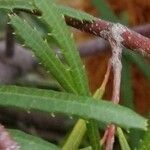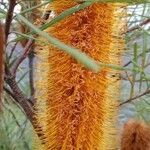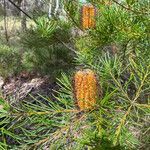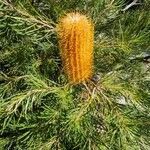Shrub to 3 m tall, with or without lignotuber. Bark smooth with lenticels or becoming tessellated. Stems tomentose or hirsute, glabrescent. Leaves alternate; petiole 1-3 mm long; lamina narrowly to broadly linear, 3-12 mm long, obtuse; margins revolute, recurved or almost flat, shortly serrate to entire; upper surface hirsute, glabrescent; lower surface closely woolly. Inflorescence 6-12 cm long; involucral bracts fine, tomentose, persistent. Flowers golden or yellow; style golden, orange, red or black. Perianth 23-29 mm long including limb of 3-3.5 mm, pubescent outside, also inside in upper part. Pistil hooked, 30-40 mm long, glabrous except a few hairs on ovary; pollen presenter narrowly ovoid, 0.5 mm long. Old perianths usually persistent; styles soon falling. Follicles up to 100, elliptic to rhombic, 10-24 mm long, 5-7 mm high, 3-14 mm wide, flattened or rounded along suture, usually shouldered, slightly wrinkled, pubescent. Seed obovate, 12-20 mm long; seed body obovate, oblique, 6-10 mm long, 3-5 mm wide, smooth.
More
A medium spreading shrub. It grows 1-4 m tall. It can spread 1-4 m across. The leaves are narrow and the edges of the leaves are rolled under. The edges have small teeth. The leaves are green above and paler underneath. They are 2-10 cm long by 0.2-0.7 cm wide. The flowers are golden yellow. They are in flower heads up to 18 cm long. The fruit are follicles and the seed are retained after maturity.




